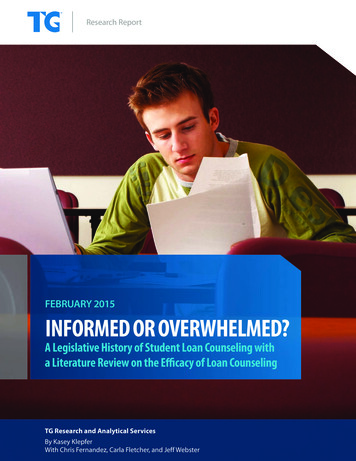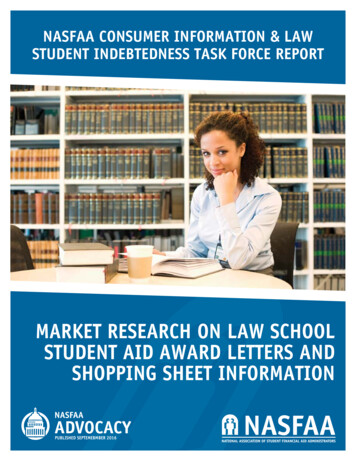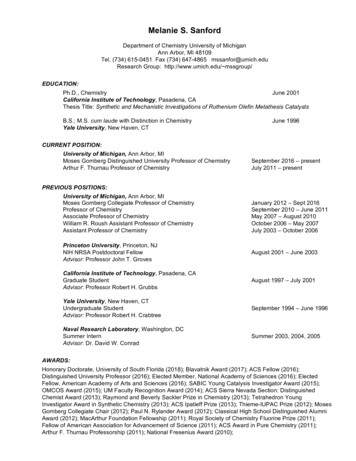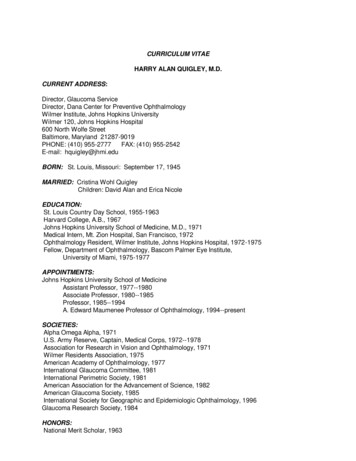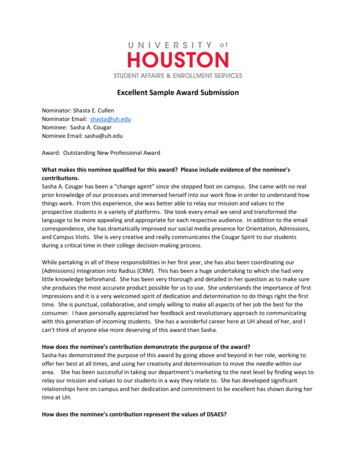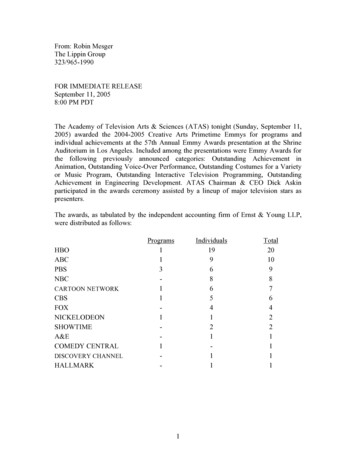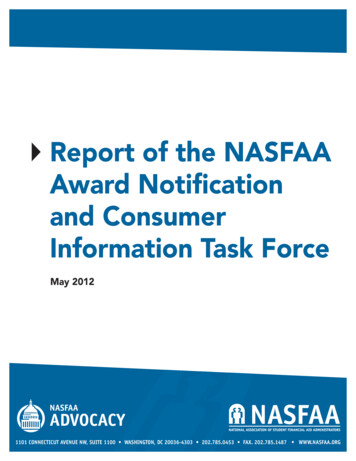
Transcription
4Report of the NASFAAAward Notificationand ConsumerInformation Task ForceMay 20121101 CONNECTICUT AVENUE NW, SUITE 1100 WASHINGTON, DC 20036-4303 202.785.0453 FAX. 202.785.1487 WWW.NASFAA.ORG
Executive SummaryThe financial aid award notification process is a topic of great importance to the ObamaAdministration, Congress, and the U.S. Department of Education. The National Association ofStudent Financial Aid Administrators (NASFAA) also values the importance of clear, concise,accurate information for students and parents, and recognizes there are ways to improveaward letters.While some have called for the complete standardization of the award letter, NASFAA membershave concerns that over‐prescriptive standardization of award letters would interfere with aninstitution’s ability to meet the specific needs of its unique student body, and would restrictinnovation and delivery. However, NASFAA supports standardizing elements and terms onaward letters.Knowing that the process of improving award letters should be informed by the professionalswho use them, the NASFAA Board of Directors commissioned the Award Notification andConsumer Information Task Force in November of 2011. The task force was charged withexamining best practices in award notification and providing recommendations to the NASFAABoard of Directors to improve or standardize elements of award notifications. The task forcewas comprised of NASFAA members representing the public and private sector, including two‐year, four‐year and graduate/professional institutions. A few themes clearly emerged from thetask force: A well‐presented, easy‐to‐understand financial aid award notice is critical and shouldbe a top‐priority for all financial aid offices.Standardization of the content, terminology and definitions contained in an awardnotice is critical.Flexibility in the format of the award notice is critical so that institutions can bestleverage whatever delivery method (e.g. paper, web‐self‐service, email, mobile app,etc.) is available to them and best suits their particular student population.Based on their research, the task force developed the recommendations detailed in this report.The recommendations are organized into four topics: Core Elements of an Award NotificationGlossary of Standardized Award Letter TerminologyLoan Aggregator and CalculatorStudent Consumer InformationAs Congress and the U.S. Department of Education explore ways to strengthen financial aidaward letter notifications, we encourage them to consider the recommendations put forth byNASFAA’s Award Notification Task Force, particularly those related to core elements andstandardized terminology. Incorporating the recommendations of the professionals who assistiReport of the Award Notification Task Force 2012 NASFAA
students on a daily basis and have the best working knowledge of the financial aid programswill help maximize the effectiveness of award letters and avoid unintended, negativeconsequences of over‐prescriptive standardization.iiReport of the Award Notification Task Force 2012 NASFAA
Core Elements of an Award NotificationRecommendation #1: The following 10 elements should be specified as core elements to beincluded on every award letter/notification.1. Cost of AttendanceThe federally defined Cost of Attendance (COA) should be listed on every award letter ornotification to students. At a minimum, this cost of attendance should include: Expected charges for one year for tuition and mandatory fees Room and board (for on‐campus residents) Estimated living expenses (for off‐campus residents) Estimated transportation costs Estimated books and supplies costs Estimated miscellaneous costs2. Scholarship and Grant Awards (Gift Aid)This element should include gift aid from all sources (federal, state, institutional, andprivate). Award notifications should transparently indicate awards that are gifts asopposed to self‐help (work‐study or loans) so that students can easily calculate their netcosts after gift aid.3. Net Costs After Gift AidIt is essential that students understand what their financial responsibility will be aftergift aid is subtracted.Optionally, schools should consider displaying how much of the gift aid will cover directcosts in addition to the overall net cost after gift aid. For example, if total gift aid is 5,000, direct costs are 8,000 and indirect costs are 7,000, the display of net costswould be:Net Direct Costs after Gift Aid 3,000Net Total Costs after Gift Aid 10,0004. Self‐Help OptionsSelf‐help includes all student loan and work‐study awards. Parent PLUS loans would beincluded in this section if the school chooses to include these in the award notification.The student should be advised that loans would be used to help pay the remaining netcosts after gift aid.1Report of the Award Notification Task Force 2012 NASFAA
5. AssumptionsThe award notification should include (or contain links to) the assumptions used todetermine aid awards as well as any conditions that must be met to continue to receivethe awards, such as: Enrollment status, including effect on award amounts/levels Housing status General terms and conditions Award‐specific terms and conditions6. Link to Resource of Total Loan Debt (Aggregator) and Calculator from ED or otherThird PartySee following section in this report on loan aggregators and calculators for details.7. Link to Consumer Information DisclosuresSee section in this report on Student Consumer Information disclosures for details.8. Link to a Public Glossary of Standard Terms and DefinitionsThe U.S. Department of Education has a glossary that can be used for this dents/english/Glossary.jsp.(Note: this public glossary would differ from the glossary used to standardize terms onthe award letter, described in Appendix A of this report.)9. Contact Information for the Financial Aid Office10. Deadlines and Next StepsThis includes all action that the student must take, and by what date, to receive thefinancial aid (all or part) contained on the award notice.Optionally, institutions should provide links to financial planning tools and “financingyour education” websites so that families can explore different scenarios regarding howmuch of their resources to use vs. how much to borrow.2Report of the Award Notification Task Force 2012 NASFAA
Recommendation #2: Components of the cost of attendance should be broken down into two,clearly labeled classifications:1. Direct Costs Expected charges for one year for tuition and mandatory feesRoom and board (for on‐campus residents)2. Indirect Costs Estimated living expenses (for off‐campus residents)Estimated transportation costsEstimated books and supplies costsEstimated miscellaneous costsThe task force recognizes that sometimes optional on‐campus housing can be classified aseither direct or indirect when displaying the Cost of Attendance using the direct andindirect classifications. In this case, the more likely scenario (e.g., student’s housingpreference on the FAFSA, the housing amount used in the budget on the system for thestudent, etc.) should be the basis for whether living expenses are classified as direct. Ifindirect is chosen in this case, the option for on‐campus housing should be indicated in thedescription.Example 1: On‐campus housing is either mandatory or is listed on the FAFSA:Direct costs billed by the institution:Tuition and Fees5,000Room and Board6,000Total Direct Costs11,000Estimated indirect costs (actual amounts vary based on individual circumstances)Books and Supplies600Transportation500Miscellaneous400Total Estimated Indirect Costs 900Total Estimated Costs of Attendance3Report of the Award Notification Task Force11,900 2012 NASFAA
Example 2: On‐campus housing is optional and not listed on the FAFSA:Direct costs billed by the institution:Tuition and Fees5,000Total Direct Costs5,000Estimated indirect costs (actual amounts vary based on individual circumstances)Living Expenses – either on‐campus room and board or off‐campus housingexpenses6,000Books and Supplies600Transportation500Miscellaneous400Total Estimated Indirect Costs 6,900Total Estimated Costs of Attendance11,900Example 3: On‐campus housing is not an option:Direct costs billed by the institution:Tuition and Fees5,000Total Direct Costs5,000Estimated indirect costs (actual amounts vary based on individual circumstances)Off‐Campus Living Expenses 6,000Books and Supplies600Transportation500Miscellaneous400Total Estimated Indirect Costs 6,900Total Estimated Costs of Attendance4Report of the Award Notification Task Force11,900 2012 NASFAA
Loan Aggregator and CalculatorRecommendation #3: Students should be informed of the potential debt they may incur at acollege before paying the enrollment deposit.Recommendation #4: Award notifications should provide enrolled students with theircumulative loan history (federal and private) and the ability to calculate repayment estimatesbefore they borrow additional loans to pay their college costs.The task force recognizes that there is a need to standardize the delivery of this informationfrom schools. For schools to provide their respective students with this type of loan history,there needs to be one comprehensive database where all educational loans (federal andprivate) are reported.Recommendation #5: The U.S. Department of Education should mandate that all educationalloans from private lenders as well as from colleges and universities be reported to one, centraldatabase.This may mean an expansion of the data collected by the National Student Loan Data System(NSLDS) or the creation of another database or loan aggregator. The task force proposes thatthe model award notification would provide a link for students to this database as the singlepoint of contact for all of their educational loans. Then all students would have access to theirentire debt portfolio in real time so they can calculate a more accurate amount of monthlyrepayments they will or could have.Regarding loan repayment calculation (both potential and cumulative debt), the task forcestrongly recommends that this capability be provided through a common tool, rather than eachinstitution developing the tool themselves. All college students who borrow student loans musthave access to a national standardized loan repayment calculator that is created by/and orsponsored by the U.S. Department of Education. This standardized calculator should be similarto the one that existed in Direct Loan Servicing that was eliminated when the servicing ofFederal Direct Loans moved to multiple servicers who have contracts with the Department.This calculator also should be located in the educational loan database site that would be thesingle point of all education loans so all students would have a standardized calculator todetermine their repayment options. In addition, there should be a version of the calculator forstudents to use who do not have any loan history but would like to determine how much theymay need to borrow for their first student loan.5Report of the Award Notification Task Force 2012 NASFAA
Student Consumer InformationRecommendation #6: Each award notification sent to students, both prospective andreturning, should include a link to a school‐created web resource that contains links to studentconsumer information, loan counseling, cumulative indebtedness, student loan default rate,repayment information, glossary of financial aid terms, federal student loan history, the CollegeNavigator, and the school’s net price calculator. This web resource should also link to non‐federal student loan history (once this resource is available) and the College Scorecard.The task force concludes that students and families should be provided with the most completeinformation possible to assist in making decisions about where to attend college and how topay for it. Providing the same or similar information in the same or similar format will enablestudents and families to more easily compare the information provided by each school whilegiving schools the flexibility to provide information unique to their institution and sector.The table in Appendix B shows the recommended name for each link and its destination. Thequestion posed beneath each link will inform the user as to the specific information available atthe linked site.While schools would have the flexibility to include links to other resources, the task forcerecommends that the web resource contain only the most essential information. By limiting theamount of information provided via this resource, the student and the student’s family aremore likely to review all of the information provided and use those tools that are mostimportant to their unique family situations.6Report of the Award Notification Task Force 2012 NASFAA
Appendix AGlossary of Terms for Award NotificationsThe Glossary of Terms for Award Notifications contains universally accepted definitions oflanguage typically contained on award notifications. The goals of the glossary are:a. to provide colleges community‐defined and accepted definitions of common terms usedon institutional award notifications;b. to provide greater clarity and understanding by students through consistency in the useand meaning of terms on award notifications across all colleges and universities; andc. to allow prospective students to more easily compare information from multiple schoolsbecause terms used have common definitions.Cost of Attendance: The estimated cost of attending this institution for one academicyear. This amount includes: Expected charges for one year of tuition and feesa. Tuition – Charges assessed for classesb. Fees – Charges assessed for other college services Room and board for resident students Estimated living expense ‐‐ allowance for rent, utilities, and food for off‐campus living Estimated transportation costs Estimated books and supplies Miscellaneous costsDirect Costs: Expenses the student/family pays to the college.Indirect Costs: Expenses the student/family may pay to a third party (merchant, landlord, etc.)other than the collegeNet Cost: Amount of direct and indirect costs remaining after all gift aid (scholarship and grant)is subtracted.Out‐of‐Pocket Cost: Difference between the cost of attendance and all gift aid. Out‐of‐pocketcost can be covered through a variety of sources, including savings, income and educationalloans.Family Financial Responsibility: Many schools award institutional scholarships and grantsbased on a more comprehensive calculation of family financial circumstances using informationprovided on the CSS PROFILE or the College’s own financial aid form. This can result in a higher(or lower) financial responsibility for the student (and his/her family) than the Free Applicationfor Federal Student Aid (FAFSA) might indicate with its Expected Family Contribution (EFC)estimate.7Report of the Award Notification Task Force 2012 NASFAA
Expected Family Contribution (EFC): A measure of how much the student/family can beexpected to contribute to the cost of the student’s education for the year. The EFC is calculatedaccording to a formula specified in the law and is based upon the information provided by thestudent and his or her family during the FASFA filing process.Gift Aid: funds awarded to the student that do not have to be repaid, unless the student failsto meet certain terms, such as a service requirement, specified as a condition of the grant. Giftaid includes awards with titles such as grants, scholarships, remissions, waivers, etc. Gift aidcan be awarded based on many factors, including (but not limited to) financial need, academicexcellence, athletic, musical, and theatrical talent, affiliation with various groups, or careeraspirations.Grant: Gift aid awarded to the student that does not need to be repaid. Grants are typicallybased on financial need.Scholarship: Gift aid awarded to the student that does not need to be repaid. Scholarshipawards are typically based on merit or a combination of merit and need, such as academicexcellence, talent, affiliation with various groups, or career aspirations.Self Help: Financial aid in the form of loans or student employment. Loans are used to helppay the remaining net costs after gift aid is deducted. Student employment earnings (includingwork study awards) are not deducted from billed costs but can be used to help cover indirectcosts and are paid in the form of wages to the student.Educational Loan: A form of financial aid that must be repaid with interest. Educational loanshave varying interest rates and repayment terms. Students and/or parents are required to signa promissory note when accepting an educational loan.1. Student Loan: Funds awarded to the student that must eventually be paid back to thelender by the student.a. Federal Direct Student Loan: Loan funds provided to the student by the U.S.Department of Education, through the school. Repayment of principal begins sixmonths after the borrower ceases to be a student on at least a half‐time basis.The FAFSA is the annual application. There are two types of Federal DirectStudent Loans: subsidized and unsubsidized. Students with financial need canqualify for a subsidized loan, and the government pays the interest on the loanwhile the student remains enrolled at least half time. Students that don’tdemonstrate financial need qualify for an unsubsidized loan and interest accrueswhile the student is in school.b. Federal Perkins Loan: A low interest loan for educational expenses provided bythe federal government for qualified individuals with exceptional financial8Report of the Award Notification Task Force 2012 NASFAA
need. The Federal Perkins Loan needs to be repaid with interest once thestudent is no longer enrolled at least half‐time (6 credit hours).c. Federal Grad PLUS Loan: Loan funds provided to graduate students by the U.S.Department of Education, through the school. This federal loan program allowsgraduate students with no adverse credit history to apply for up to their Cost ofAttendance each year, less any financial aid. To be eligible, the student must beenrolled at least half time in an eligible program of study and first borrow themaximum allowable through the Federal Direct Student Loan program.Repayment of principal and interest begins 30 to 60 days after the loan is fullydisbursed with deferment and forbearance options available.d. Private (Alternative) Loan: A loan from a commercial, state‐affiliated orinstitutional lender used to pay for up to the annual cost of education, less anyfinancial aid received. Private loans usually require the applicant to becreditworthy, or have a co‐signer and have varying interest rates, fees andrepayment options. Repayment of interest (and often principal) generallybegins immediately, with some lenders offering deferment options for in‐schoolperiods.2. Federal Parent Loan (PLUS): A federal loan program that allows parents who have noadverse credit history to apply for up to the Cost of Attendance each year, less anyfinancial aid. PLUS loans must be repaid with interest.Federal Work‐Study (FWS): A program that provides part‐time employment to studentsattending institutions of higher education who need the earnings to help meet their costs ofpostsecondary education and encourages students receiving FWS assistance to participate incommunity service activities.Federal Supplemental Educational Opportunity Grant (FSEOG): A grant provided by thefederal government to qualified undergraduate students who demonstrate exceptionalfinancial need.Federal Pell Grant: A grant provided by the federal government to qualified undergraduatestudents who demonstrate exceptional financial need and have an Expected FamilyContribution below a threshold designated annually by the U.S. Department of Education.Enrollment Status: Academic workload (or course load), as defined by the institution, that astudent is carrying for a defined academic period. This normally relates to the number of credithours or clock hours taken by a student during a given academic period. For most traditionalbased, semester schools full‐time status at least 12 credit hours, three‐quarter time status 9‐11 credit hours, and half‐time status 6‐8 credit hours. For most clock hour schools full‐timeenrollment equates to at least 24 clock hours per week.9Report of the Award Notification Task Force 2012 NASFAA
Enrollment Level: Level of the degree‐granting program in which a student is enrolled. Thereare three basic levels of enrollment: undergraduate (students seeking an associate’s degree,certificate or a baccalaureate degree); graduate (students working on a master’s degree orprofessional degree); and post‐graduate, students enrolled in a doctorial program. Theamounts and types of financial aid a student is eligible for is determined, in part, by theirenrollment level.Verification: Process to confirm the accuracy of data provided by the applicant on the FreeApplication for Federal Student Aid (FAFSA). In order to complete the verification process,students are required to provide certain documents to the school for review.10Report of the Award Notification Task Force 2012 NASFAA
Appendix BStudent Consumer What information do I needbefore deciding where to attendcollege?LoanCounselingWhat does it mean to borrow tofinance my education?CumulativeIndebtednessHow much could I owe when Igraduate?Student LoanDefault RateSchoolGraduationand RetentionRatesWhat is the school's defaultrate?DestinationSchools’ consumer information disclosureswebpageU.S. Department of Education’s Office of FederalStudent ed.action?page entranceSchool's gainful employment website orCollege ge Navigatorhttp://nces.ed.gov/collegenavigator/How many of the school'sstudents continue and graduatefrom their chosen program?College mentInformationHow much will my payments bewhen I go into repayment?U.S. Department of Education’s Office of FederalStudent /english/repaying.jspFederalStudent AidHistoryCollegeComparisonToolNet PriceCalculatorNon‐FederalStudent LoanHistoryCollegeScorecardHow much federal student aidhave I received in loans andgrants?Where can I compareinformation about the schools Iam considering?What should I expect my out‐of‐pocket costs to be for one year?11National Direct Student Loan Data Systemwww.nslds.ed.govCollege l's net price calculatorHow much have I borrowed innon‐federal education loans?Not currently availableComing soonNot currently availableReport of the Award Notification Task Force 2012 NASFAA
Appendix CNASFAA Award Notification and Task ForceChair: Doug Levy – Macomb Community CollegeMembers: Anthony Sozzo – New York Medical College, Member of the NASFAA Graduate &Professional Issues Committee Ben Burton – Ivy Tech Community College of Indiana Brenda Brown – University of Miami School of Law Dan Davenport ‐ University of Idaho, Chair of the NASFAA Federal Issues Committee Diane Stemper – The Ohio State University Eileen O’Leary ‐ Stonehill College, NASFAA Board Member Michelle Stipp – DeVry University Myrna Perkins – Barton Community College Nancy Hoover – Denison University Paula Luff – DePaul University, NASFAA Board Member Terri LeGrand – Wake Forest University12Report of the Award Notification Task Force 2012 NASFAA
Executive Summary The financial aid award notification process is a topic of great importance to the Obama . 1 Report of the Award Notification Task Force . This may mean an expansion of the data collected by the National Student Loan Data System (NSLDS) or the creation of another database or loan aggregator. .


